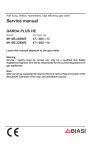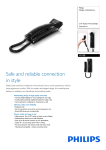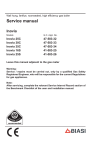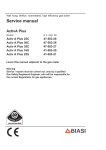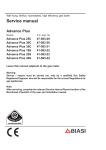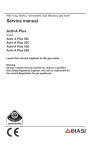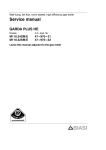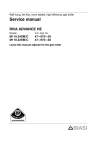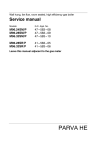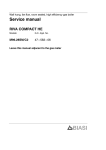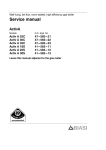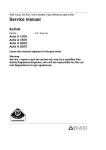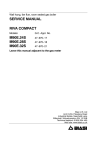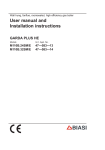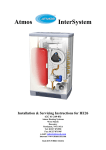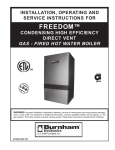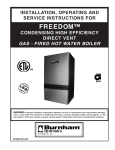Download Service manual
Transcript
Wall hung, fanflue, roomsealed, high efficiency gas boiler Service manual RIVA ADVANCE HE Models G.C. Appl. No. M110B.24SM/C47---583---11 M110B.32SM/C47---583---12 M110B.24SR/C41---583---07 Leave this manual adjacent to the gas meter Warning: Service / repairs must be carried out, only by a qualified Gas Safety Registered Engineer, who will be responsible for the current Regulations for gas appliances. Note: After servicing, complete the relevant Service Interval Record section of the Benchmark Checklist of the user and installation manual. Table of contents 1 Overall information . . . . . . . . . . . . . . . . . . . . . . . . . 4 1.1 1.2 Overall View . . . . . . . . . . . . . . . . . . . . . . . . . . . . . . . . . . . . . 4 Hydraulic diagram . . . . . . . . . . . . . . . . . . . . . . . . . . . . . . . . . 4 2 General access and emptying hydraulic circuits . . . . . . . . . . . . . . . . . . . . . . . . . . . . . . . . . . . . . . . . . 5 2.1Nomenclature . . . . . . . . . . . . . . . . . . . . . . . . . . . . . . . . . . . . 5 2.2 Body panels . . . . . . . . . . . . . . . . . . . . . . . . . . . . . . . . . . . . . 5 2.3 Control panel . . . . . . . . . . . . . . . . . . . . . . . . . . . . . . . . . . . . 5 2.4 Access to the sealed chamber . . . . . . . . . . . . . . . . . . . . . . . 6 2.5 Emptying the primary circuit . . . . . . . . . . . . . . . . . . . . . . . . . 6 2.6 Emptying the d.h.w. circuit . . . . . . . . . . . . . . . . . . . . . . . . . . 6 3Diagrams . . . . . . . . . . . . . . . . . . . . . . . . . . . . . . . . . . . . . 7 3.1 3.2 3.3 Wiring diagram M110B.24SM/... M110B.32SM/... . . . . . . . . 7 Wiring diagram M110B.24SR/... . . . . . . . . . . . . . . . . . . . . . . 8 Circuit voltages . . . . . . . . . . . . . . . . . . . . . . . . . . . . . . . . . . . 9 4Fault finding . . . . . . . . . . . . . . . . . . . . . . . . . . . . . . . . 10 5Condensing heat exchanger . . . . . . . . . . . . . . . . 12 5.1Function . . . . . . . . . . . . . . . . . . . . . . . . . . . . . . . . . . . . . . . 12 5.2Removal . . . . . . . . . . . . . . . . . . . . . . . . . . . . . . . . . . . . . . . 12 5.3Cleaning . . . . . . . . . . . . . . . . . . . . . . . . . . . . . . . . . . . . . . . 13 6D.h.w. heat exchanger . . . . . . . . . . . . . . . . . . . . . . . 14 6.1Function . . . . . . . . . . . . . . . . . . . . . . . . . . . . . . . . . . . . . . . 14 6.2Removal . . . . . . . . . . . . . . . . . . . . . . . . . . . . . . . . . . . . . . . 14 7PUMP . . . . . . . . . . . . . . . . . . . . . . . . . . . . . . . . . . . . . . . . .15 7.1Function . . . . . . . . . . . . . . . . . . . . . . . . . . . . . . . . . . . . . . . 15 7.2Checks . . . . . . . . . . . . . . . . . . . . . . . . . . . . . . . . . . . . . . . . 15 7.3 Removal pump . . . . . . . . . . . . . . . . . . . . . . . . . . . . . . . . . . 15 7.4 Removal electrical capacitor . . . . . . . . . . . . . . . . . . . . . . . . 16 8Three way diverter valve . . . . . . . . . . . . . . . . . . . 17 8.1Function . . . . . . . . . . . . . . . . . . . . . . . . . . . . . . . . . . . . . . . 17 8.2Checks . . . . . . . . . . . . . . . . . . . . . . . . . . . . . . . . . . . . . . . . 17 8.3 Removal of the electric actuator . . . . . . . . . . . . . . . . . . . . . 17 8.4 Removal of the tree way diverter valve . . . . . . . . . . . . . . . 18 8.5 Removal of the diverter group . . . . . . . . . . . . . . . . . . . . . . 18 9Electronic control/ignition p.c.b. . . . . . . . . . . . 19 9.1Function . . . . . . . . . . . . . . . . . . . . . . . . . . . . . . . . . . . . . . . 19 9.2 Selection and adjustment devices . . . . . . . . . . . . . . . . . . . 19 9.3 Checking the temperature . . . . . . . . . . . . . . . . . . . . . . . . . 20 9.4 Operation lights . . . . . . . . . . . . . . . . . . . . . . . . . . . . . . . . . 21 9.5 Setting the boiler control function modes . . . . . . . . . . . . . . 21 9.6 Adjustment of maximum useful output in c.h. mode . . . . . . 21 9.7 Reignition frequency setting . . . . . . . . . . . . . . . . . . . . . . . . 22 9.8 Combi / C.H. only mode setting . . . . . . . . . . . . . . . . . . . . . 22 9.9 Setting the d.h.w. flowmeter operation mode . . . . . . . . . . . 23 9.10Checks . . . . . . . . . . . . . . . . . . . . . . . . . . . . . . . . . . . . . . . . 24 9.11 Removal of the electronic control p.c.b . . . . . . . . . . . . . . . 24 9.12 Thermal control in the mode . . . . . . . . . . . . . . . . . . . . 26 9.13 Thermal control in the mode . . . . . . . . . . . . . . . . . . . . 27 10Transformer . . . . . . . . . . . . . . . . . . . . . . . . . . . . . . . . 28 10.1Removal . . . . . . . . . . . . . . . . . . . . . . . . . . . . . . . . . . . . . . . 28 10.2 Check the transformer . . . . . . . . . . . . . . . . . . . . . . . . . . . . 28 12Primary circuit flow switch . . . . . . . . . . . . . . . . 32 12.1Function . . . . . . . . . . . . . . . . . . . . . . . . . . . . . . . . . . . . . . . 32 12.2Checks . . . . . . . . . . . . . . . . . . . . . . . . . . . . . . . . . . . . . . . . 32 12.3Removal . . . . . . . . . . . . . . . . . . . . . . . . . . . . . . . . . . . . . . . 32 13Expansion vessel and temperature-pressure gauge . . . . . . . . . . . . . . . . . . . . . . . . . . . . . . . . . . . . . . . 33 13.1Function . . . . . . . . . . . . . . . . . . . . . . . . . . . . . . . . . . . . . . . 33 13.2Checks . . . . . . . . . . . . . . . . . . . . . . . . . . . . . . . . . . . . . . . . 33 13.3 Removal of the expansion vessel . . . . . . . . . . . . . . . . . . . . 33 13.4 Removal of the temperature-pressure gauge . . . . . . . . . . . 33 14D.h.w. flowmeter, filter and flow limiter . . . 34 14.1Function . . . . . . . . . . . . . . . . . . . . . . . . . . . . . . . . . . . . . . . 34 14.2 Description and location of parts - (Figure 14.2) . . . . . . . . 34 14.3 Removal of the sensor . . . . . . . . . . . . . . . . . . . . . . . . . . . . 34 14.4Checks . . . . . . . . . . . . . . . . . . . . . . . . . . . . . . . . . . . . . . . . 34 14.5 Removal of the flow switch group and d.h.w. circuit filter . . 34 14.6 Flow limiter . . . . . . . . . . . . . . . . . . . . . . . . . . . . . . . . . . . . . 35 15TEMPERATURE PROBE . . . . . . . . . . . . . . . . . . . . . . . . . 36 15.1Function . . . . . . . . . . . . . . . . . . . . . . . . . . . . . . . . . . . . . . . 36 15.2Checks . . . . . . . . . . . . . . . . . . . . . . . . . . . . . . . . . . . . . . . . 36 15.3 Removal of the c.h. Temperature probe . . . . . . . . . . . . . . . 36 15.4 Removal of the d.h.w. Temperature probe . . . . . . . . . . . . . 36 16By-pass valve . . . . . . . . . . . . . . . . . . . . . . . . . . . . . . . . 38 16.1Function . . . . . . . . . . . . . . . . . . . . . . . . . . . . . . . . . . . . . . . 38 16.2Removal . . . . . . . . . . . . . . . . . . . . . . . . . . . . . . . . . . . . . . . 38 17Fan and Air box . . . . . . . . . . . . . . . . . . . . . . . . . . . . . . 39 17.1Function . . . . . . . . . . . . . . . . . . . . . . . . . . . . . . . . . . . . . . . 39 17.2 Removal of the Air box and the Fan . . . . . . . . . . . . . . . . . . 39 18Ignition and detection electrodes, burner and spark generator . . . . . . . . . . . . . . . . . . . . . . . 40 18.1Function . . . . . . . . . . . . . . . . . . . . . . . . . . . . . . . . . . . . . . . 40 18.2 Removal of the Ignition and detection electrodes . . . . . . . . 40 18.3 Removal of the burner . . . . . . . . . . . . . . . . . . . . . . . . . . . . 40 18.4 Removal of the front insulation panel . . . . . . . . . . . . . . . . . 41 18.5 Removal of the rear insulation . . . . . . . . . . . . . . . . . . . . . . 41 18.6 Removal of the spark generator . . . . . . . . . . . . . . . . . . . . . 42 18.7Checks . . . . . . . . . . . . . . . . . . . . . . . . . . . . . . . . . . . . . . . . 42 19Safety thermostat . . . . . . . . . . . . . . . . . . . . . . . . . . 43 19.1Function . . . . . . . . . . . . . . . . . . . . . . . . . . . . . . . . . . . . . . . 43 19.2Checks . . . . . . . . . . . . . . . . . . . . . . . . . . . . . . . . . . . . . . . . 43 19.3Removal . . . . . . . . . . . . . . . . . . . . . . . . . . . . . . . . . . . . . . . 43 20Flue temperature probe NTC and Safety thermal fuse . . . . . . . . . . . . . . . . . . . . . . . . . . . . . . . . . . . . . 44 20.1Function . . . . . . . . . . . . . . . . . . . . . . . . . . . . . . . . . . . . . . . 44 20.2Removal . . . . . . . . . . . . . . . . . . . . . . . . . . . . . . . . . . . . . . . 44 20.3Checks . . . . . . . . . . . . . . . . . . . . . . . . . . . . . . . . . . . . . . . . 44 21Condensate trap . . . . . . . . . . . . . . . . . . . . . . . . . . . . 45 21.1Function . . . . . . . . . . . . . . . . . . . . . . . . . . . . . . . . . . . . . . . 45 21.2 Check the cleanness of the trap . . . . . . . . . . . . . . . . . . . . . 45 21.3Removal . . . . . . . . . . . . . . . . . . . . . . . . . . . . . . . . . . . . . . . 45 22Short spare parts list . . . . . . . . . . . . . . . . . . . . . . 46 11 Gas valve . . . . . . . . . . . . . . . . . . . . . . . . . . . . . . . . . . . . 29 11.1Function . . . . . . . . . . . . . . . . . . . . . . . . . . . . . . . . . . . . . . . 29 11.2 Nomenclature of the parts . . . . . . . . . . . . . . . . . . . . . . . . . 29 11.3Adjustment . . . . . . . . . . . . . . . . . . . . . . . . . . . . . . . . . . . . . 29 11.4Checks . . . . . . . . . . . . . . . . . . . . . . . . . . . . . . . . . . . . . . . . 30 11.5 Removal of the gas valve . . . . . . . . . . . . . . . . . . . . . . . . . . 30 -3- OVERALL INFORMATION 1 Overall information 1.1 Overall View Flue temperature probe NTC Safety thermal fuse Condensing heat exchanger air purger valve Condensing heat exchanger Burner Ignition electrodes Detection electrode Expansion vessel Spark Generator C.h. temp. probe Transformer Air box Safety thermostat Gas restrictor Fan C.h. pressure relief valve Air hose Automatic air purger valve Main circuit flow switch D.h.w. Flow Switch Codensate trap Pump Diverter valve Gas valve D.h.w. temp. probe Control panel Condensate trap D.h.w. heat exchanger Figure 1.1 1.2 Hydraulic diagram Central heating (c.h.) operation C.h. water return Figure 1.2 -4- C.h. water flow Domestic hot water (d.h.w.) operation D.h.w. inlet D.h.w. outlet GENERAL ACCESS AND EMPTYING HYDRAULIC CIRCUITS 2 General access and emptying hydraulic circuits 2.1 Nomenclature A 1 2 6 Figure 2.2 3 To remove the side panels loosen the screws C and D (Figure 2.3), bring the base of the panels away from the boiler and lift them, freeing them from the top hooks. 5 4 B Figure 2.1 1 2 3 4 5 6 Right side panel Front panel Control panel lid Control panel cover Service panel Left side panel C D 2.2 Body panels Warning: isolate the boiler from the mains electricity supply before removing any covering or component. For the most part of the check and maintenance operations it is necessary to remove one or more panels of the case. The side panels can be removed only after the removal of the front panel. To remove the front panel remove screws A (Figure 2.2), lift the panel and remove it. Figure 2.3 - Bottom view of the boiler 2.3 Control panel Warning: isolate the boiler from the mains electricity supply before removing any covering or component. To gain access to the parts located inside the control panel proceed as follows: 1 Remove the front panel of the case 2 Loosen the screws C and D (Figure 2.3). 3 Remove the screws B. 4 Move the lower part of the side panels as indicated in Figure 2.4 and pull the control panel. When completely pulled out, the panel can rotate 45° downwards to facilitate the service operations on the internal parts. Figure 2.4 -5- GENERAL ACCESS AND EMPTYING HYDRAULIC CIRCUITS 5 Remove the screws E and remove the service panel (Figure 2.5); 6 Remove the screws F and remove the control panel lid (Figure 2.5). F H F E Figure 2.7 Attention: some water could remain in the condensing heat exchanger. 5 Close drain tap once the emptying has been completed. Figure 2.5 I 2.4 Access to the sealed chamber G Figure 2.8 I G Figure 2.9 2.6 Emptying the d.h.w. circuit Figure 2.6 To gain access to the parts contained in the sealed chamber it is necessary to remove the lid of the sealed chamber. For this purpose, remove the front and side panels of the case, remove the screws G as indicated in Figure 2.6 and remove the lid. 2.5 Emptying the primary circuit 1 Close the c.h. circuit flow and return cocks fitted by the installer. 2 Remove the front and right panels of the boiler. 3 Open the drain tap I (Figure 2.8 combi or Figure 2.9 only c.h.) until the boiler is completely emptied. 4 To help the draining of the primary circuit loose the condensing heat exchanger air purger valve H (Figure 2.7). -6- J Figure 2.10 1 Close the d.c.w. inlet cock J (Figure 2.10). 2 Open one or more hot water taps until the boiler has been completely emptied. DIAGRAMS 3 Diagrams 3.1 Wiring diagram M110B.24SM/... M110B.32SM/... Electric supply terminal block External controls terminal block bn gnye bu 3 2 bn bu 1 Pump 1 gnye bu bk bn bn D.h.w. temperature probe NTC C.h. temperature probe NTC N M ~ 3 Gas valve bk bn bu 2 1 bk bk bk 5 gnye K4 K1 K3 wh OUT rd bu X10 gy gy wh bk bk rd X9 X6 bu bn X1 rd bu wh bk gy X5 bu bn X23 X22 X15 F3 bu bn wh rd T3 bn 5V GND gy wh wh K2 gnye X16 wh X11 X17 X3 bu bu bu F1 rd t bk rd X14 gnye gnye F2 D.h.w. flow switch rd bu bn X12 X7 t bu bu bn bu bk bk bn bk bu bk bu 4 bu X13 L Three way diverter valve X2 X24 wh LD3 LD2 LD1 P3 P6 bn bn bu bu LD4 SB1 bn bu bk bu rd wh gy Spark Generator Transformer 230V~ / 24V~ bn = brown bu = blue bk = black wh = white rd = red gy = grey gn = green ye = yellow vt = violet og = orange gnye = green/yellow rdwh = red/white NO rd M ~ og wh rd Primary circuit flow switch bk wh COM Fan Flame detection electrode rd bk wh gy t Ignition electrodes gy gn gy Flue temperature probe NTCgy Safety thermostat Time switch t wh Safety thermal fuse Figure 3.1 -7- DIAGRAMS 3.2 Wiring diagram M110B.24SR/... Electric supply terminal block N C.h. temperature probe NTC External controls terminal block bn gnye bu 3 2 Gas valve Pump 1 4 5 bn bn bu bk bu gnye bu bn bu bn X14 X12 K4 K1 X9 X6 bu bn X1 rd bu wh bk gy X5 bu bn X23 X22 X15 F3 bu bn gy gy T3 bn gy wh wh wh bk bk rd X16 gnye X3 K2 wh rd K3 F1 X10 bu bu F2 X11 X17 gnye gnye X7 t bu bu bn bu gnye bk bk bu bk bn bu 1 X13 L X2 X24 wh LD3 LD2 LD1 P3 P6 bn bn bu bu LD4 SB1 bn bu bk bu rd wh gy Spark Generator Transformer 230V~ / 24V~ bn = brown bu = blue bk = black wh = white rd = red gy = grey gn = green ye = yellow vt = violet og = orange gnye = green/yellow rdwh = red/white Figure 3.2 -8- NO rd M ~ og wh rd Primary circuit flow switch bk wh COM Fan gy t Ignition electrodes Flame detection electrode gy gy Flue temperature probe NTCgy Safety thermostat t wh Safety thermal fuse DIAGRAMS 3.3 Circuit voltages during c.h. or d.h.w. operation Electrical voltages with burner on only during c.h. operation only during d.h.w. operation 3 way diverter valve 0 D.h.w. Flow switch 0 230~ 230~ 0...32 Hz 230~ 230~ Supply network Gas valve 33...200 Hz 230~ Pump X14 X12 F1 K4 X3 X10 K2 K1 K3 F2 X11 X17 X7 X16 X13 X23 X22 X15 F3 X9 T3 X5 X1 X6 X2 X24 P3 P6 SB1 LD4 Transformer Figure 3.3 0 24= 24~ 230~ 0 LD3 LD2 LD1 Fan Safety Main circuit thermostat pressure switch -9- Lock--- out signal lamp red ON Defect C.h. circuit Diverter valve D.h.w. heat exchanger D.h.w. circuit 9.9 The boiler lights for a short while on c.h. Normal operation on d.h.w. function. The boiler doesn’t control the d.h.w. temperature. Turning the d.h.w. temp. adjustment knob hasn’t effect on the modulation of the flame. The boiler operates correctly on c.h. The burner doesn’t light either in c.h. or d.h.w. mode. Fan doesn’t turn. The burner doesn’t light either in c.h. or d.h.w. mode. Fan turns. Pump 8.2 D.h.w. flow switch The boiler does not start either in c/h or d.h.w. mode. All the operation lights OFF Fan still. Condensate drain pipe and trap 7.2 Fuses (Electronic p.c.b.) 6 Electronic p.c.b. By pressing the reset push--- button the boiler starts the ignition cycle. The burner lights on and the boiler locks again. Flue pipes --(4) 11.4 12.2 14.5 Gas valve Main circuit flow switch 15.2 Main circuit temp. probe D.h.w. temp. probe 16 By--- pass valve 17 18.7 Fan air restrictor Spark generator 18.7 Ignition electrode Detection electrode 19.2 19.2 20.1 Safety thermostat Gas restrictor Boiler settings Components to check Flue temperature probe NTC D.h.w. filter ----- 21.1 ( (3) NO TAG ) By pressing the reset push--- button the boiler starts the ignition cycle. The burner doesn’t light on and the boiler locks again. Power supply line Transformer --(1) Gas supply line By pressing the reset push--- button the boiler turns on and operates correctly. OFF 10 --(7) Expansion vessel - 10 --- Safety valve --- 4 Pressure gauge Section of the manual (note ref. in brackets) FAult finding Fault finding --(1) Gas supply line Power supply line Transformer 1 Check for 230V~ between line (L) and neutral (N) Verify the integrity of supply cable, plug and external fuses. Check the polarity of line and neutral connection Useful information can be obtained also from the optical indication given by the appliance operation lights (see section 9.4). Note 5 4 A jammed by--- pass could cause the over--- heating of the main circuit and the intervention of the safety thermostat. Check the gas supply pipe and isolation tap for gas tightness. Check for soundness and absence of obstructions. Verify that the flue terminal is correctly installed (see clearances) and ensure that exhaust gas is not sucked back by the boiler. Check for soundness of the circuit and verify its correct filling (see also installation manual). Water leaks from the safety valve when the boiler is off. 11.4 12.2 14.5 --2 3 Condensate drain pipe and trap --- Fuses (Electronic p.c.b.) Electronic p.c.b. Boiler settings Water leaks from the safety valve during operation on c/h D.h.w. flow switch 9.9 Gas valve Low d.h.w. flow rate 8.2 Main circuit flow switch (8) 7.2 D.h.w. filter Poor d.h.w. temperature. Regular operation in c/h mode. Poor c.h. / d.h.w. temperature (9) Noisy bolier Incorrect modulation D.h.w. circuit D.h.w. heat exchanger On c/h mode the temperature of the main circuit reaches 90 C and the c/h system does not heat. The boiler operates correctly on d.h.w. mode. C.h. circuit 6 Pump Flue pipes --(4) 15.2 Main circuit temp. probe D.h.w. temp. probe By--- pass valve --- --- The boiler doesn’t reach the nominal heat input. --(7) 9 Spark generator d.h.w. pressure too high or flow rate too high. If necessary insert a flow rate limiter (14.6). Ignition electrode 8 Detection electrode Check the pressurization of the expansion vessel. Refer to the installation manual for proper values. 19.2 19.2 20.1 Safety thermostat 7 Fan air restrictor 18.7 Gas restrictor Using the flue analyzer, check the CO 2 value of the flue gases. This reading is a reference value for the gas valve setting. 17 18.7 Flue temperature probe NTC 6 16 Expansion vessel ----- 21.1 ( (3) NO TAG ) Diverter valve The boiler does not supply d.h.w. (cold water from the tap). Regular operation in c/h mode even during a drawing off d.h.w. OFF F Lock--- out signal lamp red Defect 10 Safety valve Section of the manual (note ref. in brackets) Pressure gauge Components to check FAult finding - 11 - Condensing heat exchanger 5 Condensing heat exchanger 5.1 Function The Condensing heat exchanger A in Figure 5.1 has the function of transferring heat produced from combustion of the gas and from the flue exhausted gas to the water circulating in it. N A D M L E I H K C J F B Figure 5.1 By reducing the combustion products temperature, the latent heat of the vapour is transferred to the water circuit, allowing an extra gain of useful heat. The condensed vapour is then drained through the condensate trap B and the draining pipe C. 5.2 Removal Warning: isolate the boiler from the mains electricity supply before removing any covering or component. G Figure 5.2 10 Loosen the connection G and slightly move the pipe F upwards, turn it towards left (Figure 5.2) and then move the pipe downwards freeing it from the Condensing heat exchanger. R 1 Disconnect the flue system from the boiler. 2 Remove the fan group (rubber pipe, gas pipe) following the instructions from 1 to 6 in section "Removal of the Air box and the Fan" page 39. 3 Disconnect the detection electrode connector D, the ignition electrodes connector L and the earth wire M. 4 Disconnect the fan connector I by pressing the plastic hook placed on the side of the connector (Figure 5.2). 5 Unscrew the nuts N (Figure 5.2). 6 Remove the fan-burner group H. 7 Empty the primary circuit of the boiler. 8 Remove the clips E (Figure 5.2). 9 Loosen the connection J and slightly move the pipe K upwards, turn it towards left (Figure 5.2) and then move the pipe downwards freeing it from the Condensing heat exchanger. Q P Figure 5.3 O 11 Using pliers, remove the spring O moving it downwards and disconnect the rubber pipe P (Figure 5.3). 12 Unscrew the screws Q and remove the clamps (Figure 5.3). 13 Disconnect the two connectors R by pressing the plastic hook placed on the side of the connector (Figure 5.3). - 12 - Condensing heat exchanger 14 Remove the Condensing heat exchanger by levering it and sliding it forwards. 15 Reassemble the Condensing heat exchanger carrying out the removal operations in reverse order. Ensure to tighten the nuts N - Figure 5.2 firmly. 5.3 Cleaning If there are deposits of dirt on the coil of the Condensing heat exchanger, clean with a bristle paintbrush and remove the dust with a hoover. Warning: After cleaning or replacement as detailed above, if it deemed necessary to undertake a combustion analysis as detailed in chapter 11.3 section 11. S Figure 5.4 Caution: After any periodical servicing or disturbance the combustion chamber silicon seal S Figure 5.4 must be fully inspected and replaced at the discretion of the service engineer. After any disturbance to the chamber door seal the appliance must undergo a full analytical combustion performance check. - 13 - D.h.w. heat exchanger 6 D.h.w. heat exchanger A 6.1 Function The d.h.w heat exchanger A in Figure 6.1 and Figure 6.3 allows the instantaneous transfer of heat from the primary hydraulic circuit to the water destined for d.h.w use. D B C F E A Figure 6.3 6 Completely unscrew the Allen key screws G (Figure 6.4) which hold the exchanger to the plastic groups. A Figure 6.1 G The schematic structure is shown in Figure 6.2. Figure 6.4 7 Move the exchanger towards the rear of the boiler and extract it. Reassemble the d.h.w. heat exchanger carrying out the removal operations in the reverse order. Warning: to lubricate the O-ring gaskets exclusively Primary hydraulic circuit Figure 6.2 Domestic hot water circuit 6.2 Removal Warning: isolate the boiler from the mains electricity supply before removing any covering or component. 1 Remove the front and right hand side panels of the case. 2 Empty the primary circuit and the d.h.w circuit of the boiler. 3 Remove the pump B in Figure 6.3 (see section "Removal pump" page 15. 4 Remove the clip C and remove the primary circuit pressure switch D by lifting it upwards. It is not necessary to disconnect it from the wiring. 5 Remove the clip E and remove the electric actuator F by pulling it. It is not necessary to disconnect it from the wiring. - 14 - use a silicone base grease compatible to be in contact with foods and approved by the local water Authorities. Warning: When reassembling the exchanger be sure to put the off center location/securing pin indicated in Figure 6.5 towards the left side of the boiler. Figure 6.5 PUMP 7 PUMP Check that the impeller is integral with the rotor. 7.1 Function The pump A in Figure 7.1 and Figure 7.4 has the function of making the water in the main circuit circulate through the main heat exchanger, the condensing heat exchanger and therefore through the c.h. system (during the c.h. function) or through the secondary heat exchanger (during the d.h.w. function). With the boiler off remove the front and right hand side case panels, lower the control panel and empty the primary circuit. Remove the pump head by undoing the screws which hold it to the pump body and check that the impeller is firmly joined to the rotor. 480 Ω 213 Ω A Coil 2 Coil 1 Figure 7.2 Figure 7.1 7.2 Checks Warning: isolate the boiler from the mains electricity supply before removing any covering or component. Check that the pump is not seized and that the movement of the rotor is not subject to mechanical impediments. With the boiler off, remove the front panel. Remove the air release plug of the pump and turn the rotor with a screwdriver. Check the electrical continuity. 7.3 Removal pump Warning: isolate the boiler from the mains electricity supply before removing any covering or component. 1 Remove the case panels and the sealed chamber lid (section "Body panels" page 5). 2 Empty the primary circuit of the boiler. 3 Disconnect the connector G (Figure 7.4) following the indications given on the connector box. 4 Disconnect the earth connector E (Figure 7.4). 5 Loosen the connection D (Figure 7.3), and pull up and turn to the left the pipe C. 6 Remove the locking plate H (Figure 7.5). With the boiler off, remove the front panel and disconnect the connector G (Figure 7.4). Measure the electrical resistance between the pump supply connections. Electrical resistance of the windings (at ambient temperature) must be about 213 Ω (coil 1) and 480 Ω (coil 2) (Figure 7.2). Check the absence of starting defects. With the boiler off remove the front case panel. Remove the air release plug from the pump. Start the boiler and with a screwdriver, turn the rotor in the direction of the arrow. If there is a defect in starting, the rotor will begin to turn normally only starting it manually. - 15 - PUMP Reassemble the pump carrying out the removal operations in the reverse order. When reassembling the pump, check the correct location of the O-ring gasket in the inlet port of the pump that seals the connection between the pump and the return water group. B 7.4 Removal electrical capacitor Warning: isolate the boiler from the mains electricity supply before removing any covering or component. 1 Remove the front and right hand side case panels. 2 Disconnect the connector G (Figure 7.4) following the indications given on the connector box. 3 Remove the connector I of the cover box by levering with a screwdriver in as shown in (Figure 7.6). C D I Figure 7.3 E G Figure 7.6 A 4 Remove the capacitor connection block J freeing it from the hook K and pulling it as indicated by the arrow (Figure 7.7). J F Figure 7.4 H Figure 7.5 7 Unscrew the two screws and remove the pump. - 16 - Figure 7.7 that hold the pump on the frame K Three way diverter valve 8 Three way diverter valve 8.1 Function The diverter valve A (Figure 8.1) has the function of modifying the hydraulic circuit of the boiler by means of an electric command given by the electronic control p.c.b. in order to send the water that exits the primary heat exchanger towards the c.h. system or towards the d.h.w. heat exchanger. B Spindle visible 9,4 Kohm Open circuit A Figure 8.1 230 V Figure 8.2 D.h.w. mode 0V bn bu bk B Spindle not visible bk = black bu = blue bn = brown Open circuit 9,4 Kohm 8.2 Checks Figure 8.3 C.h. mode Figure 8.2 indicates the relationship between the electric command coming from the electronic control p.c.b. and the position of the actuator B (brass spindle) when the boiler operates in d.h.w. mode. Figure 8.3 indicates the relationship between the electric command coming from the electronic control p.c.b. and the position of the actuator B (brass spindle) when the boiler operates in c.h. mode. In both figures the relationship between the position of the actuator and the resistance of the motor windings (the motor must be disconnected from the wiring) is also given. 0V Warning: check the electrical continuity. 230 V bn bu bk bk = black bu = blue bn = brown 8.3 Removal of the electric actuator Warning: isolate the boiler from the mains electricity supply before removing any covering or component. 1 Remove the front case panel. 2 Disconnect the connectors C (Figure 8.4). 3 Remove the fixing spring D and remove the actuator B. Reassemble the actuator carrying out the removal operations in the reverse order. When reassembling the actuator, refer to Figure 8.2 or to the wiring diagram in section "Checks" page 17 for the correct wiring connection. - 17 - Three way diverter valve 8.5 Removal of the diverter group 1 Remove the front and both side case panels. 2 Empty the primary circuit and the d.h.w circuit of the boiler. 3 Remove the electric actuator (section "Removal of the electric actuator" page 17). 4 Remove the fixing spring H (Figure 8.6) and remove the primary circuit pressure switch I. C D B H I Figure 8.4 8.4 Removal of the tree way diverter valve 1 Remove the front and both side case panels. 2 Empty the primary circuit and the d.h.w circuit of the boiler. 3 Remove the electric actuator (section "Removal of the electric actuator" page 17). 4 Remove the fixing spring E (Figure 8.5) 5 Remove the tree way diverter valve F by levering with a screwdriver in as shown in Figure 8.5. J Figure 8.6 5 Disconnect d.h.w. temperature probe, respectively K (Figure 8.7). F G K Figure 8.7 E Figure 8.5 Reassemble the tree way diverter valve carrying out the removal operations in the reverse order. Warning: to lubricate the O-ring gaskets exclusively use a silicone base grease compatible to be in contact with foods and approved by the local water Authorities. Warning: When reassembling the tree way diverter valve be sure that the tree way diverter is correctly oriented by matching the reference G with the notch of the water group Figure 8.5. - 18 - 6 Unscrew the connector I (Figure 8.6), the c.h. flow connector and the d.h.w. outlet connector. 7 Remove the d.h.w. heat exchanger (section "Removal pump" page 15). 8 Unscrew the screws and remove the diverter group. 9 Reassemble the diverter group carrying out the removal operations in the reverse order. Warning: to lubricate the O-ring gaskets exclusively use a silicone base grease compatible to be in contact with foods and approved by the local water Authorities. Electronic control/ignition p.c.b. 9 Electronic control/ignition p.c.b. 9.1 Function Inlet Information On the p.c.b....... Electronic control/ignition Function control C.h. temperature adjustment D.h.w. temperature adjustment Boiler reset button (control panel fascia) From other boiler devices.... C.h. temperature probe NTC D.h.w. temperature probe NTC D.h.w. flow switch Primary circuit flow switch Flue temperature probe NTC Safety thermal fuse Safety thermostat Flame detection electrode Room thermostat (if fitted) Time switch operating in order to keep the temperature of the hydraulic circuits constant. This is obviously possible within the useful power and maximum working temperature limits foreseen. Generally, the Electronic control/ignition p.c.b. receives inlet information coming from the boiler (the sensors) or from the outside (knobs, room thermostat, etc.), processes it and consequently acts with outlet commands on other components of the boiler (Figure 9.1). The Electronic control/ignition p.c.b. is also a full sequence ignition device and does a sequence of operations (ignition cycle) which lead to the ignition of the gas at the burner. It checks the presence of the flame during the entire period in which it is activated and supplies the fan regulating its speed. The Electronic control/ignition p.c.b. has a safety function and any incorrect interventions or tampering can result in conditions of dangerous functioning of the boiler. The Electronic control/ignition p.c.b. can lock the functioning of the boiler (lock state) and stop its functioning up to the resetting intervention. The lock is signalled by the lighting of the lock---out signal lamp and the device can be reset only by using the boiler reset button placed on the control panel fascia. Some components which are connected to the device can activate the lock state. The causes of a lock state could be: • The intervention of the safety thermostat (overheat of the primary circuit). • The intervention of the flue temperature probe (overheat of the combustion products). • A fault on gas supply. • Faulty ignition (faulty ignition electrodes, their wiring or connection). • Faulty flame detection (faulty detection electrode, its wiring or connection). • Faulty condensate drainage. • Faulty gas valve (faulty on-off operators or not electrically supplied). • Faulty Electronic control/ignition p.c.b. Other components like the primary circuit flow switch can temporarily stop the ignition of the burner but allow its ignition when the cause of the intervention has stopped. Figure 9.23 and Figure 9.24 show the sequence of the operations that are carried out at the start of every ignition cycle and during normal functioning. Outlet command Pump Three way diverter valve Gas valve Fan Ignition electrodes Appliance operation lights* Lock---out signal lamp* *control panel fascia 9.2 Selection and adjustment devices On the Electronic control/ignition p.c.b. several selection, adjustment and protection devices are located. (Figure 9.2). Some of these devices are directly accessible by the user (function control, temperature adjustment potentiometers etc.) others, like the fuses, are accessible by removing the service panel. Figure 9.1 The fundamental function of the Electronic control/ignition p.c.b. is that of controlling the boiler in relation to the external needs (i.e. heating the dwelling or heating the water for d.h.w. use) and - 19 - Electronic control/ignition p.c.b. 1 20 Figure 9.2 2 3 4 5 6 7 19 18 17 16 15 14 8 13 9 10 11 12 1 x7 - x16 connector - electric supply terminal block and external controls terminal block. 2 Fuse F1, F2 3,15 A F 3 Fuse F3, 400 mA T 4 x15 connector - flame detection electrode 5 x12 connector - pump and 3 way diverter valve 6 x17 connector - gas valve 7 x14 connector - external temperature probe (optional) 8 x9 connector - safety thermostat, flue temperature probe NTC, c.h. temperature probe NTC 9 x11 connector - d.h.w. temperature probe 10 x10 connector - d.h.w. flow switch 11 x13 connector - remote control (optional) 12 x2 connector - timer 13 Lock-out signal lamp 14 Boiler reset button 15 Function control / C.h. temperature adjustment 16 x22 connector - fan 17 x6 connector - spark generator 18 D.h.w. temperature adjustment 19 x5 - x24 connector - transformer 20 Appliance operation lights Figure 9.3 When the boiler functions in d.h.w. (Figure 9.4), the signal coming from the d.h.w. temperature probe is compared with the signal given by the control panel through the adjustment made by the user (knob ). 9.3 Checking the temperature The Electronic control/ignition p.c.b. makes it possible to separately adjust the c.h. water flow temperature and d.h.w. outlet temperature. The temperature of the water is converted into an electric signal by means of temperature probes. The user, setting the desired temperature with the control panel knobs operates the variable elements (15 and 18 in Figure 9.2) of the electronic control p.c.b. If the power requested is lower than 40% of the maximum power output then control is achieved by switching ON the burner at minimum power, then switching OFF (ON/OFF function). If the power requested is higher, then the burner is switched ON at maximum power and will control by modulating to 40% of the maximum power output. During the c.h. operation (Figure 9.3), the signal coming from the c.h. temperature probe is compared to the signal given by the control panel through the adjustment made by the user (knob ). The result of such a comparison operates the fan speed thus regulating the gas flow rate and consequently changing the useful output of the boiler. - 20 - 90 °C Figure 9.4 Normally, the result of the comparison between these two signals directly operates the fan speed adjusting the useful output gen- Electronic control/ignition p.c.b. erated in order to stabilize the temperature of the exiting water. Flue temperature probe NTC lock out If during the d.h.w. mode operation, the temperature of the primary circuit goes over 90°C, the useful output is automatically reduced so that the primary circuit cannot reach excessive temperatures. Open flue temperature probe NTC Faulty external temperature probe NTC The control sequences in function and in function are illustrated in detail in sections 9.12 page 26 and 9.13 page 27. Flame detection error Lack of power supply or faulty electronic control p.c.b. Faulty Electronic control/ignition p.c.b.. * 9.4 Operation lights The Electronic control/ignition p.c.b. is provided with three lamps (L.E.D. indicators) 20 in Figure 9.2 that give optical information during the operation of the boiler. Lamp OFF The green lamp on the left gives information whether the boiler is in stand-by mode or during the normal operation of the boiler. Flashing lamp,alone or simultaneously with another lamp The following table gives the relationship between the lamps indication and their meaning. Boiler in stand-by condition. (function control in position). A seconds A short short pulse pulse every every 4 4 seconds Anti- freeze system active. 1 1 second second ON ON 1second 1second OFF OFF With the boiler switched ON ( ure 9.2) are activated. Boiler ON condition (function control in position) or or ) all the lamps (20 in Fig- Lamp ON Flashing lamp, alternate with another lamp * These conditions are normal only for a short time when the power supply is applied to the boiler. If permanent they indicate a faulty p.c.b. 9.5 Setting the boiler control function modes It is possible to select the various boiler control function modes by using the function selector knob 7 and the D.h.w. temperature control knob 8 (Figure 9.5). On model M110B.24SR/... the knob 8 is used just for boiler setting and doesn’t affect the boiler functions during the normal operation. During the function modes setting, the boiler does not operate. The following table gives the relationship between each of the possible lamp combinations and their meaning. Normally operating boiler (see the previous table for details) C.h. operation D.h.w. operation Frost protect operation D.h.w. operation Excessive temperature on primary circuit Faulty c.h. temperature probe NTC Faulty d.h.w temperature probe NTC 11 Figure 9.5 8 7 9 10 9.6 Adjustment of maximum useful output in c.h. mode The following procedure allows the output of the boiler for c.h. to be limited to meet the system requirement. Adjusting the maximum useful output in c.h. mode does not prevent the boiler firing at maximum rate for d.h.w. production. 1 Turn the boiler ON positioning the function selector knob 7 as indicated in Figure 9.6. Faulty primary circuit (no water or absence of flow) Lack of burner ignition Safety thermostat lock out Faulty fan control system Figure 9.6 11 8 7 9 10 - 21 - Electronic control/ignition p.c.b. 2 Keep pressed the reset button 9 for about 10 seconds until the lock-out signal lamp 10 blinks. 3 The lamps 11 should give the indication as in Figure 9.7 (maximum c.h. useful output adjustment). If not, press the reset button repeatedly to obtain it. Where: Lamp OFF Lamp ON Figure 9.7 At this step it is possible to visualize the current setting by keeping the reset button 9 pressed for more than 5 seconds. The lamps will flash a number of times corresponding to the setting (Figure 9.8 and Figure 9.9). 11 8 Figure 9.10 7 9 2 Keep pressed the reset button 9 for about 10 seconds until the lock-out signal lamp 10 blinks. 3 The lamps 11 should give the indication as in Figure 9.11 (reignition frequency). If not, press the reset button repeatedly to obtain it. Where: 4 To change the setting turn the knob 8 on a position corresponding to the desired maximum useful output (Figure 9.8 and Figure 9.9). By turning the knob 8, the lock-out signal lamp 10 blinks quickly (2 per seconds) indicating that the setting has changed and must be memorised. Knob position 1 2 3 4 5 6 7 Maximum useful output in c.h. mode non condensing kW (BTU/h) M110B.24SM/... M110B.32SM/... M110B.24SR/... 5,8 (19 789) 8,2 (27 977) 9,0 (30 707) 12,4 (42 307) 12,2 (41 625) 16,5 (56 296) 15,5 (52 884) 20,7 (70 626) 18,7 (63 802) 24,8 (84 614) 21,9 (74 720) 29,0 (98 944) 25,1 (85 638) 33,1 (112 933) Figure 9.8 2 4 5 Lamp OFF Lamp ON Figure 9.11 At this step it is possible to visualize the current setting by keeping the reset button 9 pressed for more than 5 seconds. The lamps will flash a number of times corresponding to the setting (Figure 9.12). 4 To change the setting turn the knob 8 on a position corresponding to the desired delay. By turning the knob 8, the lock-out signal lamp 10 blinks quickly (2 per seconds) indicating that the setting has changed and must be memorised. 3 1 1/2 3 10 0 4 3 4 5 1/2 5 2 7 6 7 1 8 1/2 6 1 7 8 Figure 9.12 Figure 9.9 5 To memorize the setting keep pressed the reset button 9 for about 5 seconds until the lights 11 briefly blinks simultaneously. 6 To reset the boiler to the normal operation turn it OFF and ON by the function selector knob 7. In any case, the boiler automatically resets to its normal operation after 10 minutes. Delay (minutes) Setting No. 5 To memorize the setting keep pressed the reset button 9 for about 5 seconds until the lights 11 briefly blinks simultaneously. 6 To reset the boiler to the normal operation turn it OFF and ON by the function selector knob 7. In any case, the boiler automatically resets to its normal operation after 10 minutes. Factory setting = 3 minutes 9.7 Reignition frequency setting It is possible to select the minimum time that must pass between two ignitions of the burner in c.h. function mode. 1 Turn the boiler ON positioning the function selector knob 7 as indicated in Figure 9.10. - 22 - 9.8 Combi / C.H. only mode setting Two different options are available on the Electronic control/ignition p.c.b. and proper setting must be done after a replacement of the p.c.b. 1 Remove the front panel of the case. 2 Turn ON the power supply. 3 Position the function selector 7 as in Figure 9.14 and disconnect the C.h. temperature probe. Lamps 11 give the indication as in Figure 9.13. Electronic control/ignition p.c.b. Where: Lamp OFF Lamp Flashing Figure 9.13 4 Keep pressed the reset button 9 for about 10 seconds (Figure 9.14) until the lock-out signal lamp 10 blinks. 5 Connect the c.h. temperature probe. a number of times corresponding to the setting as in Figure 9.16 (once for the combination and four times for system boilers). At this point only the right green light flashes. 10 Turn the water control to minimum. Lock-out lamp blinks (2 per second) indicating the setting has changed 11 To change the setting turn the knob 8 on a position corresponding to the boiler model (Figure 9.16). 12 To memorize the setting keep pressed the reset button 9 for about 5 seconds until the lights 11 briefly blinks simultaneously. At this point only the right green light flashes. 13 To reset the boiler to the normal operation turn it OFF and ON by the function selector knob 7. 9.9 Setting the d.h.w. flowmeter operation mode 11 Figure 9.14 8 7 9 10 6 Press the reset button 9 repeatedly (2 times) until the lamps 11 give the indication as in Figure 9.15 (boiler mode). Where: Lamp OFF Lamp ON When replacing the Electronic control/ignition p.c.b., it must be set for the correct operation of the d.h.w. flowmeter. Note: the Electronic control/ignition p.c.b. spare part is fattory set on mode 1. For all the models covered by this manual: 1 Turn the boiler ON positioning the function selector knob 7 as indicated in Figure 9.18. 2 Turn knob 8 as indicated in Figure 9.18. Figure 9.15 At this step it is possible to visualize the current setting by keeping the reset button 9 pressed for more than 5 seconds. The lamps 11 will flash a number of times corresponding to the setting (Figure 9.16). M110B.24SR/... 4 flashes M110B.24SM/... M110B.32SM/... 1 flash 11 Figure 9.18 8 7 9 10 3 Keep pressed the reset button 9 for about 10 seconds until the lock-out signal lamp 10 blinks. 4 Press the reset button 9 repeatedly (4 times) until the lamps 11 give the indication as in Figure 9.19 (setting the d.h.w. flowmeter mode operation). Where: 8 Lamp OFF Lamp ON Figure 9.16 7 To change the setting turn the knob 8 on a position corresponding to the boiler models (Figure 9.16). By turning the knob 8, the lock-out signal lamp 10 blinks quickly (2 per seconds) indicating that the setting has changed and must be memorised. 8 To memorize the setting keep pressed the reset button 9 for about 5 seconds until the lights 11 briefly blinks simultaneously. 9 Press the reset button 9 once until the lamps 11 give the indication as in Figure 9.17 (boiler mode). Where: Lamp OFF Lamp ON Figure 9.17 Figure 9.19 At this step it is possible to visualize the current setting by keeping the reset button 9 pressed for more than 5 seconds. The lamps 11 will flash a number of times corresponding to the setting (Figure 9.20). 5 Change the setting by turning the knob 8 on the position corresponding to the desired setting (Figure 9.20). By turning the knob 8, the lock-out signal lamp 11 blinks quickly (2 per seconds) indicating that the setting has changed and must be memorised. 6 To memorize the setting keep pressed the reset button 9 for about 5 seconds until the lights 11 briefly blinks simultaneously. It’s now possible to check the current setting by pressing reset button 9 for more than 5 seconds. The three lamps 11 will flash - 23 - Electronic control/ignition p.c.b. D.H.W. FLOWMETER 7 flashes 4 3 Remove the spindles of the c.h. and d.h.w. temperature adjustment knobs by delicately pulling them with pliers in the direction shown by the arrow in Figure 9.21. 7 1 8 Figure 9.20 Setting No. At this step it is possible to visualize the current setting by keeping the reset button 9 pressed for more than 5 seconds. The lamps 11 will flash a number of times corresponding to the setting of Figure 9.20 that must be seven times. 7 To reset the boiler to the normal operation turn it OFF and ON by the function selector knob 7 checking the ignition pressure and that the burner lights up uniformly. In any case, the boiler automatically resets to its normal operation after 10 minutes. 9.10Checks Check that the fuses are complete If the Electronic control/ignition p.c.b. does not supply any device (pump, fan, etc.) check that the fuses 2 and 3 (Figure 9.2) are complete. If a fuse has blown replace it with one that has the same characteristics after having identified the reason for failure. Lock sequence Start the boiler until the burner is ignited. With the burner firing, interrupt the gas supply. The Electronic control/ignition p.c.b. must carry out three complete ignition cycles and then, after about 3 minutes, goes to lock-out state. By turning the boiler on and off by means of the function switch the device must not unlock and the burner must not turn on. 9.11Removal of the electronic control p.c.b Figure 9.21 4 Unscrew the four screws that hold the Electronic control/ignition p.c.b. on to the control panel. 5 Remove it by lifting its rear edge and freeing it from any of the wiring. 6 Re-assemble the Electronic control/ignition p.c.b. following the removal procedures in the reverse order. Important When re-assembling the Electronic control/ignition p.c.b.: 7 It is not necessary to utilise static protections but it is advisable to ensure that the p.c.b. is handled with care and held at the edges and with clean dry hands. 8 Fit the p.c.b. into the control panel by first inserting the front lower edge under the control knob shafts. Lower the rear edge and ensure that no wiring is trapped beneath. 9 Insert the spindles in the control panel knobs until the notch A (Figure 9.22) reaches the potentiometer edge. It is not necessary to force them in the knob. 10 While tightening the screws that fix the Electronic control/ignition p.c.b. on the control panel, keep the p.c.b. towards the control panel fascia making sure of the contact between the boiler reset button B and the tab C (Figure 9.22). Warning: isolate the boiler from the mains electricity supply before removing any covering or component. When replacing the Electronic control/ignition p.c.b. it is advisable to go through the setting modes of the boiler here described in sections 9.5 to 9.7. The spare electronic control/ignition p.c.b. is set for natural gas. If the boiler is fed with different gas type, go through the Gas conversion operations described in the Installation manual. If an external temperature probe (optional) is fitted, the coefficient K has also to be set as described in the Commissioning chapter of the installation manual. 1 Gain access to the parts located inside the control panel as explained in the section "Control panel" page 5. 2 Remove all the wiring connected to the Electronic control/ ignition p.c.b. To disconnect the connectors delicately flex the hook present on one side of each socket. - 24 - A A Figure 9.22 B C Electronic control/ignition p.c.b. Attention After installing the Electronic control/ignition p.c.b.: 11 Make sure the c.h. ( ) and d.h.w. ( ) temperature adjustment knobs can move freely for the complete range. If not, remove the spindle again as described at step 3, turn the knob half a turn and re-insert the spindle. 12 Make sure that the settings comply with the indications given in section "Setting the boiler control function modes" page 21. 13 Operate the boiler and close the gas inlet cock so that the boiler goes into the safety lock-out state. Verify the correct operation of the boiler reset button by pressing and releasing it. Warning: After cleaning or replacement as detailed above, if it deemed necessary to undertake a combustion analysis as detailed in section "Removal" page 32. - 25 - Electronic control/ignition p.c.b. 9.12Thermal control in the mode Switch in the Taking water from the domestic hot water circuit? YES circulator on function mode circulator off fan still NO YES YES Is primary circuit temperature higher than that selected? Main circuit pressure switch consense? YES stop circulator (3min) Operation lights NO NO YES lock memorised? NO cancels lock starts fan checks fan rpm Operation lights Is fan rpm exact? NO YES Is flue temperature higher than 110°C? NO YES turns on lock--- out light Opeartion lights beginning of wait period flame presence? End of wait period? YES starts ignition discharges Opens gas valve beginning of ignition period YES NO flame presence? interrupts ignition discharges gas valve open fan runs YES NO NO End of ignition period? YES closes gas valve stops fan interrupts ignition discharges memorizes lock turns on lock--- out light NO Is fan rpm exact? NO NO YES safety thermostat or flue temperature probe lock out? YES Figure 9.23 - 26 - YES reset push--- button pressed? flame presence? YES NO Electronic control/ignition p.c.b. 9.13Thermal control in the mode Switch in the See functioning with the function control in the mode function mode Taking water from the domestic hot water circuit? YES (sec. 9.11) Request for heat from room thermostat? NO circulator on YES Is primary circuit temperature higher than that selected? circulator off fan still YES Main circuit pressure switch consense? YES NO stop circulator (3min) Operation lights NO NO YES lock memorised? NO cancels lock starts fan checks fan rpm Opeartion lights Is fan rpm exact? NO YES Is flue temperature higher than 110°C? NO YES turns on lock--- out light Opeartion lights beginning of wait period flame presence? End of wait period? YES starts ignition discharges Opens gas valve beginning of ignition period YES NO flame presence? interrupts ignition discharges gas valve open fan runs YES NO NO End of ignition period? YES closes gas valve stops fan interrupts ignition discharges memorizes lock turns on lock--- out light NO Is fan rpm exact? NO NO YES safety thermostat or flue temperature probe lock out? YES reset push--- button pressed? flame presence? YES NO YES Figure 9.24 - 27 - Transformer 10 Transformer smaller connector 10.1Removal larger connector clamp for fitting the transformer smaller connector larger connector Figure 10.2 C 10.2Check the transformer Warning: isolate the boiler from the mains electricity supply before removing any covering or component. B A Figure 10.1 Warning: isolate the boiler from the mains electricity supply before removing any covering or component. 1 Remove all the case panels and the sealed chamber lid (see section "General access and emptying hydraulic circuits" page 5). 2 Disconnect the four connectors A. 3 Unscrew the screws B and remove the Transformer C by sliding it forward. 4 Reassemble the Transformer carrying out the removal operations in the reverse order. After reassembling ensure the wires are correctly connected (see Figure 10.2). - 28 - 1 Remove the Transformer (see section "Removal" page 28) 2 Measure the electrical resistance of the primary and secondary windings. The primary should have a resistance approx. 35 ohm and the secondary approx. 1,4 ohm. gas valve 11 Gas valve 11.3Adjustment 11.1Function The gas valve A in Figure 11.1 controls the gas inflow to the boiler burner. A Figure 11.1 By means of an electric command given to the on-off operators the passage of the gas through the Gas valve can be opened or closed. 11.2Nomenclature of the parts B C D E F - (Figure 11.2) Maximum gas pressure adjustment Minimum gas pressure adjustment On-off operators On-off operators electric connector Gas valve inlet pressure test point Warning: isolate the boiler from the mains electricity supply before removing any covering or component. Check the supply pressure before making any adjustment to the gas valve. 1 Close the gas inlet valve. 2 Remove the front panel of the case and lower the control panel (see sections "Body panels" and "Control panel" page 5). 3 Loosen the internal screw on the Inlet Pressure Test Point F (Figure 11.2) of the Gas valve and connect a pressure gauge using a suitable hose. 4 Open the gas inlet valve. 5 Turn on the electricity supply to the boiler, switching on the fused spur isolation switch. The appliance operation light on the left will flash every 4 seconds. 6 Set the function knobs as illustrated in Figure 11.4. 7 Open at least one hot water tap fully. 8 Read the inlet pressure value and ensure that it is within the limits given in the table Gas supply pressures, of the user/installation manual If it does not comply with the required pressure check the gas supply line and governor for faults and/or correct adjustment. 9 Switch off the boiler close the gas inlet valve and close the water tap. 10 Disconnect the pressure gauge and close the Inlet Pressure Test Point F (Figure 11.2). Gas valve adjustment The person carrying out a combustion measurement should have been assessed as competent in the use of a flue gas analyser and the interpretation of the results. The flue gas analyser used should be one meeting the requirements of BS7927 or BS-EN50379-3 and be calibrated in accordance with the analyser manufacturers’ requirements, and have a current calibration certificate. 11 Fit the probe of the flue analyser in the flue exhaust sampling point located on the exhaust pipes of the boiler (Figure 11.3). air sampling points B flue exhaust sampling points C D F E Figure 11.2 Figure 11.3 12 Turn on the boiler, switching on the fused spur isolation switch. 13 Open the gas inlet valve. 14 Set the function knob 8 as indicated in Figure 11.4. The appliance operation light on the left will flash every 4 seconds. - 29 - gas valve 11.4Checks Warning: isolate the boiler from the mains electricity supply before removing any covering or component. 11 Figure 11.4 8 7 9 10 15 Keep pressed the reset button 9 for about 10 seconds (Figure 11.4) until the lock-out signal lamp 10 blinks. 16 The lamps 11 should give the indication as in Figure 11.5. Where: Lamp OFF Lamp ON Figure 11.5 Adjusting minimum gas valve setting 19 Set the knob 8 to the minimum position as illustrated in Figure 11.6. Figure 11.6 8 7 9 Lower on-off operator approx. 920 Ω* Figure 11.7 11.5Removal of the gas valve Warning: isolate the boiler from the mains electricity supply before removing any covering or component. 1 Remove the front panel of the case as explained in the section "Control panel" page 5, and the sealed chamber lid. 2 Remove the screw G and disconnect the connector H (Figure 11.8). K 10 20 Allow the analyser to give a stable reading. 21 Read the CO2 % value. It should be between 9,0 and 9,8 % (natural gas G20) or between 10,0 and 11,0 % (LPG G31). To adjust the CO2 %value remove the brass plug by unscrewing it and rotate the Allen key screw ø 4 mm (C - Figure 11.2) (by rotating it clockwise the CO2 % increases). Checking the maximum gas valve setting 22 Set the knob 8 to the maximum position as illustrated in Figure 11.4. 23 Allow the analyser to give a stable reading. 24 Read the CO2 % value. It should be between 9,0 and 9,8 % (natural gas G20) or between 10,0 and 11,0 % (LPG G31). To adjust the CO2 % value rotate screw (B - Figure 11.2) (by rotating it clockwise the CO2 % decreases). 25 Switch off the boiler and turn off the hot water tap(s). 26 Close the air-flue sampling points. 27 After adjustment fit the protective brass plug (C - Figure 11.2). Important: after the gas pressure checks and any adjustment operations, all of the test points must be sealed. - 30 - Upper on-off operator approx. 6400 Ω* *at ambient temperature. 17 Release and keep the reset button 9 pressed for more than 5 seconds until the lock-out signal lamp 10 is switched off. The boiler will now go through an ignition sequence and the burner will light. 18 Open at least one hot water tap fully. 11 Check the on-off operators coils 1 Remove the front panel of the case. 2 Disconnect the electrical connector E (Figure 11.2). 3 Measure the electrical resistance between the connector pins of the on-off operators as illustrated in Figure 11.7. J I G H Figure 11.8 3 Turn off the gas supply and disconnect the gas isolation cock connector from the inlet port of the gas valve. 4 Using pliers, remove the spring I and the rubber pipe J (Figure 11.8). 5 Unscrew the connector K (Figure 11.8), remove the fixing fork L and remove the pipe M (Figure 11.9). gas valve L M Figure 11.9 6 Unscrew the screws N and remove the valve (Figure 11.10). 7 Reassemble the valve carrying out the removal operations in reverse order. Figure 11.10 N Before fitting a new gas valve, it is advisable to pre-set it as hereafter explained. 8 Remove the brass plug and turn the plastic screw inside it fully clockwise until it stops. Do not over tight. 9 Turn it counter-clockwise 2 and 3/4 turns. 10 Adjust the gas valve using the flue analyser as described in section "Adjustment" page 29. After any service operation on the components of the gas circuit check all the connections for gas leaks. Warning: After cleaning or replacement as detailed above, it is deemed necessary to undertake a combustion analysis as detailed in section "Adjustment" page 29. - 31 - Primary circuit flow switch 12 Primary circuit flow switch N.O. C 12.1Function The Primary circuit flow switch (A in Figure 12.1) function is to detect water flow rate through the primary hydraulic circuit of the boiler. Figure 12.2 12.3Removal Warning: isolate the boiler from the mains electricity supply before removing any covering or component. A 1 Remove the front and right hand side panels of the case, turn off the flow and return isolation valves and empty the primary circuit. 2 Remove the fixing spring D (Figure 12.3) and remove the primary circuit pressure switch E. 3 Disconnect the connectors. B Figure 12.1 This hydraulic/membrane operated electrical micro-switch device will control the functioning of the ignition control circuit, providing there is an adequate quantity and flow of water in the primary circuit. Any failure of the pump or obstructions in the primary circuit, whilst in either c.h. or d.h.w. modes, will not allow the device to operate. This device is connected to the electronic control p.c.b. and if, after the pump operates, it does not activate within 20 seconds the control board will indicate that a fault condition (see section "Operation lights" page 21) has occurred. 12.2Checks Warning: isolate the boiler from the mains electricity supply before removing any covering or component. Electrical check It is possible to verify the general operation of the switch by measuring the electric resistance between the contacts C and N.O. of the switch. 1 Measure the electrical resistance between the tabs marked C and N.O. (Figure 12.2). The contact must close (resistance zero) with c.h. pressure of 0,35 bar or higher. - 32 - E D Figure 12.3 4 Reassemble the primary circuit pressure switch in reverse order of removal. Warning: to lubricate the O-ring gaskets exclusively use a silicone base grease compatible to be in contact with foods and approved by the local water Authorities. Expansion vessel and temperature-pressure gauge 13 Expansion vessel and temperaturepressure gauge 13.1Function The Expansion vessel (B in Figure 12.1 function is to allow for the volume expansion of the c.h. circuit water due to the temperature rise. H G 13.2Checks 1 Turn off the flow and return isolation valves and empty the primary circuit of the boiler. 2 Remove the protective cap F (Figure 13.1) from the valve on the top of the expansion vessel and connect a suitable air pressure gauge. F Figure 13.2 3 Re-assemble the parts in reverse order of removal. 13.4Removal of the temperature-pressure gauge 1 Remove the front and right hand side panels of the case, turn off the flow and return isolation valves and empty the primary circuit. 2 Remove the fork I and the probe holder spring J (Figure 13.3). 3 Squeeze the tabs K to release the temperature-pressure gauge L and remove it. 4 Re-assemble the parts in reverse order of removal. Figure 13.1 Rear view of the boiler 3 Check the pre-load pressure and refer to the section Expansion vessel in the User manual and installation instructions for the correct value. 13.3Removal of the expansion vessel If there is at least 400 mm clearance above the boiler and the rear exit flue can be easily removed, the expansion vessel can be changed without removing the boiler. Warning: isolate the boiler from the mains electricity supply before removing any covering or component. I J K L Figure 13.3 1 Remove the front and left hand side panels of the case, turn off the flow and return isolation valves and empty the primary circuit. 2 Completely unscrew the connection G,the locknut H (Figure 13.2) and remove the expansion vessel from the top of the boiler. - 33 - D.h.w. flow switch, filter and flow limiter 14 D.h.w. flowmeter, filter and flow limiter 14.1Function E The d.h.w. flowmeter A in Figure 14.1 is a device that generates an electrical signal when hot water is drawn. D B C A Figure 14.3 1 Remove the front panel of the case. 2 Disconnect the connectors B and remove the sensor holder C (Figure 14.3). 3 Remove the sensor. 14.4Checks Figure 14.1 When the flow rate through the d.h.w. circuit reaches about 2,5 litres/min’, the sensor closes the electric contact that switches the boiler d.h.w operation ON. 14.2Description and location of parts - (Figure 14.2) 1 5 Warning: isolate the boiler from the mains electricity supply before removing any covering or component. Sensor operation 0..32 Hz (without flow rate) wh bu rd 33..200 Hz (witht flow rate) 5V B rd 2 3 4 2 Figure 14.2 1 2 3 4 5 Flow switch plug O-ring Flow limiter (optional accessory) Body with flow meter turbine Filter 14.3Removal of the sensor Warning: isolate the boiler from the mains electricity supply before removing any covering or component. bu wh = white bu = blue rd = red wh Figure 14.4 1 Remove the front panel of the case. 2 Don't disconnect the connectors B 3 Measure the electrical frequency at the leads of the sensor. Without flow rate the electrical frequency must be 0÷32Hz. With flow rate the electrical frequency must be 33÷200Hz. 14.5Removal of the flow switch group and d.h.w. circuit filter Warning: isolate the boiler from the mains electricity supply before removing any covering or component. - 34 - D.h.w. flow switch, filter and flow limiter 1 Remove the front panel of the case and empty the d.h.w. circuit. 2 Remove the fork D and pull up the flow switch plug E (Figure 14.3) with the help of a screwdriver. 3 To remove the body 4 with the filter from the flow switch group rotate the flow switch plug 1 (Figure 14.5). 4 Reassemble the parts following the removing sequence in reverse order. 14.6Flow limiter The M296.24SM/C model is factory fitted with a 10 litres/min. flow limiter (white). To install the flow limiter: 1 Remove the flow switch group as explained in the section 14.5. 2 Rotate the flow switch plug 1 to separate it from the body 4 (Figure 14.5). rotate insert 1 3 4 Figure 14.5 3 Insert the flow limiter 3 as shown in Figure 14.5. 4 Reassemble the group following the above sequence in reverse order. - 35 - Temperature probe 15 TEMPERATURE PROBE 15.2Checks Temperature-resistance relationship 15.1Function The Temperature probe has the function of converting the temperature of the water in the hydraulic circuit where it is installed into an electrical signal (resistance). The relation between temperature and electrical resistance is stated in Figure 15.1. Ω 12500 12000 11500 11000 10500 10000 9500 9000 8500 8000 7500 7000 6500 6000 5500 5000 4500 4000 3500 3000 2500 2000 1500 1000 20 25 30 35 40 45 50 55 60 65 70 75 80 85 90 95 100 Figure 15.1 Warning: isolate the boiler from the mains electricity supply before removing any covering or component. Disconnect the cable from the Temperature probe. Measure the temperature of the pipe near the Temperature probe and check the electrical resistance according to the graph in Figure 15.1. 15.3Removal of the c.h. Temperature probe Warning: isolate the boiler from the mains electricity supply before removing any covering or component. 1 Remove all the case panels and the sealed chamber lid (see section "General access and emptying hydraulic circuits" page 5). 2 Empty the primary circuit of the boiler. 3 Remove the electric connector C and remove the c.h. temperature probe D - Figure 15.3. 4 Reassemble the c.h. temperature probe carrying out the removal operations in reverse order. °C D On the boiler there are two Temperature probes. One on the output of the primary heat exchanger (c.h. Temperature probe) A in Figure 15.2 and Figure 15.3; one on the output of the d.h.w. heat exchanger (d.h.w. Temperature probe) B in Figure 15.2 and Figure 15.4. C A Figure 15.3 15.4Removal of the d.h.w. Temperature probe Warning: isolate the boiler from the mains electricity supply before removing any covering or component. 1 2 3 4 B Figure 15.2 - 36 - Remove the front panel of the case. Remove the electric connector E (Figure 15.4) Remove the fork F and pull the d.h.w. Temperature probe G. Reassemble the d.h.w. Temperature probe carrying out the removal operations in reverse order. Warning: to lubricate the O-ring gaskets exclusively use a silicone base grease compatible to be in contact with foods and approved by the local water Authorities. Temperature probe G E F Figure 15.4 - 37 - By-pass valve 16 By-pass valve Warning: to lubricate the O-ring gaskets exclusively 16.1Function The By-pass valve A in Figure 16.1 is located between the c.h. water flow and return and its function is that of guaranteeing a minimum flow across the primary heat exchanger if the circulation across the c.h. system is completely closed. The By-pass valve is fitted on the rear side of the diverter group. use a silicone base grease compatible to be in contact with foods and approved by the local water Authorities. Attention: when reassembling the By-pass valve be sure that it is correctly oriented by matching the reference C with the notch D of the water group Figure 16.3. A C A Figure 16.3 Figure 16.1 16.2Removal Warning: isolate the boiler from the mains electricity supply before removing any covering or component. 1 Remove all the case panels. 2 Empty the primary circuit of the boiler. 3 Remove the locking plate B and pull up the by-pass valve A (Figure 16.2). A B Figure 16.2 4 Reassemble the by-pass valve as illustrated in Figure 16.2 reversing the order of removal. - 38 - D Fan and Air box 17 Fan and Air box K G 17.1Function The function of the Fan A (Figure 17.1) is to force the mixture of air and gas into the burner. The function of the Air box B is to mix the gas and the air in the right proportion. The flow rate of the air-gas mixture and consequently the input power of the boiler is proportional to the speed of the fan that is controlled by the electronic control p.c.b. H J L I Fan gasket Figure 17.3 B 4 Disconnect the rubber pipe G (Figure 17.3). A M Figure 17.1 Figure 17.4 17.2Removal of the Air box and the Fan Warning: isolate the boiler from the mains electricity supply before removing any covering or component. 1 Turn off the gas supply. 2 Remove all the case panels and the sealed chamber lid (see section "General access and emptying hydraulic circuits" page 5). 5 Unscrew the gas connector M (Figure 17.4) 6 Remove the fixing fork H and remove the gas pipe I (Figure 17.3). 7 Loosen without removing the screw J. 8 Remove the screws K and the air box L. Leave the air box with the air manifold clamped to the water pipe. 9 Disconnect the fan connector K by pressing the plastic hook placed on the side of the connector (Figure 17.2). 10 Unscrew the screws D (Figure 17.2). 11 Remove the fan E. 12 Assemble the Fan and the Air box carrying out the removal operations in reverse sequence. Before reassembling ensure the fan gasket (Figure 17.3) is correctly mounted. F D E Warning: After cleaning or replacement as detailed above, it is deemed necessary to undertake a combustion analysis as detailed in section "Adjustment" page 29. C Figure 17.2 3 Disconnect the air manifold C (Figure 17.2) by pulling it. - 39 - Ignition and detection electrodes 18 Ignition and detection electrodes, burner and spark generator 18.1 Function Three electrodes are fitted on the fan-burner group. Two of them, fitted on the right side of the fan-burner group A, are the ignition electrodes B and are connected to the spark generator C. On the left side is the detection electrode D and it detects the presence of the flame. I K J A B H H D I H F J E C Figure 18.2 18.2 Removal of the Ignition and detection electrodes Warning: isolate the boiler from the mains electricity supply before removing any covering or component. 1 Remove all the case panels and the sealed chamber lid (see section "General access and emptying hydraulic circuits" page 5). 2 Disconnect the ignition electrodes connector E and the earth wire F from the spark generator C (Figure 18.1) and disconnect the detection electrode connector G. 3 Unscrew the screws H and remove the ignition electrodes B and the detection electrode D (Figure 18.1). 4 Assemble the Ignition and detection electrodes carrying out the removal operation in reverse order. When reassembling the ignition electrodes be sure to connect correctly the wires to the spark generator (Figure 18.3.) earth wire G ignition electrodes wire C Figure 18.1 The burner K is fitted on the rear of the fan-burner group A. Figure 18.3 18.3 Removal of the burner Warning: isolate the boiler from the mains electricity supply before removing any covering or component. 1 Remove the air box and the fan (see section "Removal of the Air box and the Fan" page 39). 2 Remove the Ignition and detection electrodes (see section "Removal of the Ignition and detection electrodes" page 40). 3 Unscrew the screws I (Figure 18.1) and remove the cover of the combustion chamber. 4 Unscrew the screws J (Figure 18.1) and remove the Air-gas duct lid. 5 Remove the burner by sliding it forward. - 40 - Ignition and detection electrodes 40). 3 Remove the front insulation panel (Figure 18.6). 4 Assemble the new front insulation carrying out the removal operation in reverse order. When fitting the new panel ensure that the electrodes holes coincide with the holes of the combustion chamber. burner gasket front insulation Siliconic gasket Figure 18.6 locating tab Figure 18.4 6 Assemble the burner carrying out the removal operation in reverse order. Ensure the burner is correctly located by lining up the locating tab (Figure 18.4). burner gasket Air--- gas duct gasket Caution: After any periodical servicing or disturbance the combustion chamber silicon seal (Figure 18.6) must be fully inspected and replaced at the discretion of the service engineer. After any disturbance to the chamber door seal the appliance must undergo a full analytical combustion performance check. 18.5 Removal of the rear insulation See warning note at the end of this chapter before to remove this part. Attention: Cover the inner of the condensing heat exchanger to avoid that dirt and debris fall in the coil. 1 Do the operations of section "Removal of the burner" page 40 from step 1 to step 3. 2 Unscrew the screw L, remove the washer M and the rear insulation N (Figure 18.7). Figure 18.5 Before reassembling ensure the burner gasket is correctly located. Warning: After cleaning or replacement as detailed above, it is deemed necessary to undertake a combustion analysis as detailed in section "Adjustment" page 29. N L M 18.4 Removal of the front insulation panel See warning note at the end of this chapter before to remove this part. 1 Remove the Ignition and detection electrodes (see section "Removal of the Ignition and detection electrodes" page 40). 2 Remove the burner (see section "Removal of the burner" page Figure 18.7 - 41 - Ignition and detection electrodes 18.6 Removal of the spark generator Warning: isolate the boiler from the mains electricity supply before removing any covering or component. 1 Remove all the case panels and the sealed chamber lid. 2 Disconnect the spark generator connector coming from the control p.c.b, the electrode swire and the earth wire coming from the ignition electrodes (Figure 18.8). ignition electrodes wire Warning: isolate the boiler from the mains electricity supply before removing any covering or component. 7 mm earth wire O C Ignition electrode O Figure 18.8 spark generator connector 3 Unscrew the screws O and remove the spark generator. 4 Assemble the spark generator carrying out the removal operation in reverse order. Figure 18.10 When reassembling the spark generator be sure to connect correctly the wires. 1 Remove all the case panels and the sealed chamber lid. 2 Check for the integrity of the insulation of wires which connect the electrodes to the spark generator and to the control/ignition p.c.b. 18.7 Checks Check of the spark generator Warning: isolate the boiler from the mains electricity supply before removing any covering or component. There is not a significant way to verify the integrity of the spark generator. When the fan turns but the burner does not light a possible cause is a faulty spark generator and it is advisable to replace it to locate the fault. Check the position of the electrode edges Warning: isolate the boiler from the mains electricity supply before removing any covering or component. 1 Remove the ignition electrodes (see section "Removal of the Ignition and detection electrodes" page 40). 2 Check for the correct distance between the metallic edges of the ignition electrode (see Figure 18.9 - Figure 18.10). 3,5 mm earth electrode Ignition electrode Figure 18.9 Check the connection wires - 42 - Warning - Insulation panels material handling care Mineral fibres are used in this appliance for the insulation panels of the combustion chamber Excessive exposure to these materials may cause temporary irritation to eyes, skin and respiratory tract. Known hazards - Some people can suffer reddening and itching of the skin. Fibre entry into the eye will cause foreign body irritation, which can cause severe irritation to people wearing contact lenses. Irritation to respiratory tract. Precautions - Dust goggles will protect eyes. People with a history of skin complaints may be particularly susceptible to irritation. High dust levels are only likely to arise following harsh abrasion. In general, normal handling and use will not present high risk, follow good hygiene practices, wash hands before, touching eyes, consuming food, drinking or using the toilet. First aid - Medical attention must be sought following eye contact or prolonged reddening of the skin. Safety thermostat 19 Safety thermostat 19.1Function The safety thermostat A in Figure 19.1 is a device that senses the temperature of the primary circuit water which flows in the outlet pipe of the condensing heat exchanger. If the temperature control system of the boiler fails and the temperature of the primary circuit reaches a dangerous temperature, the safety thermostat opens the electric circuit that supplies the on-off operators of the gas valve. Consequently, the full sequence ignition device attempts to light the burner and, at the end, locks the boiler and lights the lock-out signal lamp. 19.3Removal Warning: isolate the boiler from the mains electricity supply before removing any covering or component. 1 Remove all the case panels and the lid of the sealed chamber. 2 Disconnect the wiring B (detail in Figure 19.2). 3 Unscrew the screws C which hold the overheat thermostat on the pipe of the condensing heat exchanger and remove it. C A B Figure 19.2 4 Reassemble the overheat thermostat carrying out the operations in reverse order. 5 Apply an adequate quantity of heat conducting compound between the pipe and the thermostat. Figure 19.1 Warning: After cleaning or replacement as detailed above, if it deemed necessary to undertake a combustion analysis as detailed in section "Adjustment" page 29. 19.2Checks Overheat temperature value 1 Set the temperature control knobs to their max. position and run the boiler in d.h.w. and c.h. 2 Allow the boiler to reach its maximum operating temperature (monitor the temperature gauge on the instrument panel). The boiler should maintain a temperature below that of the safety thermostat and no overheat intervention should occur. Warning: isolate the boiler from the mains electricity supply before removing any covering or component. Electrical function 1 Remove all the case panels and the lid of the sealed chamber. 2 Disconnect the safety thermostat and check its electrical function. Normally (no intervention) the contact must be closed (electrical resistance zero Ω). - 43 - Flue temperature probe NTC and Safety thermal fuse 20 Flue temperature probe NTC and Safety thermal fuse shown in Figure 20.3) may be damaged and must be replaced. 20.1Function The Flue temperature probe NTC A in Figure 20.1 and Figure 20.2 senses the temperature of the combustion products that flow through the condensing heat exchanger. B A Figure 20.3 20.2Removal Warning: isolate the boiler from the mains electricity supply before removing any covering or component. 1 Remove all the case panels and the sealed chamber lid. 2 Disconnect the connector C from the Flue temperature probe NTC by pressing the plastic hook placed on the side of the connector. 3 Unscrew and remove the flue temperature probe A (Figure 20.2) from the condensing heat exchanger. 4 Assemble the Flue temperature probe NTC carrying out the removal operations in reverse sequence. Figure 20.1 If the temperature of the combustion products circuit reaches the limit temperature, the Flue temperature probe NTC reduces the gas flow rate to the burner. The temperature of the combustion products should decrease to a safe value temperature. In the case that the temperature of the combustion products reaches a potentially dangerous value, it stops the boiler operation (lock-out). This allows the use of plastic materials for the flue outlet pipes and bends. The use of kits different from the original isn’t however allowed, since the flue pipes are integral parts of the boiler. A C 1 Set the temperature control knobs to their max. position and run the boiler in d.h.w. and c.h. 2 Allow the boiler to reach its maximum operating temperature (monitor the temperature gauge on the instrument panel). The boiler should maintain a temperature below that of the Flue temperature probe NTC and no overheat intervention should occur. Temperature-resistance relationship. 1 Remove the Flue temperature probe NTC section "Removal" page 44). 2 Measure the Flue temperature probe NTC electrical resistance at the ambient temperature and check it according to the graph in (Figure 20.4) Ω 12500 B Figure 20.2 A Safety thermal fuse B in Figure 20.1 - Figure 20.2 is also connected in series with the Flue temperature probe NTC and acts as a safety device in extreme case of incorrect operation of the Flue temperature control system. Reaching the breakdown temperature it opens the circuit and locks out the boiler. In case of intervention of this safety device the heat exchanger (part - 44 - 20.3Checks Overheat temperature value 12000 11500 11000 10500 10000 9500 9000 8500 8000 7500 7000 6500 6000 5500 5000 4500 4000 3500 3000 2500 2000 1500 1000 500 Figure 20.4 20 25 30 35 40 45 50 55 60 65 70 75 80 85 90 95 100 °C Condensate trap 21 Condensate trap D 21.1Function C The condensate trap A in Figure 21.1 and Figure 21.2 allows the discharge of the condensate via the condensate drain pipe avoiding in the mean time the escape of combustion products. A plastic ball closes the trap outlet in case that the trap is empty. B E A Figure 21.2 A Figure 21.1 If the drain pipe becomes blocked, or condensate cannot drain, the condensate level it the trap rises until it reaches the screw attached to the flame detection electrode, this will cause the boiler lock out. 21.2Check the cleanness of the trap Unscrew the plug on the bottom of the trap and remove dirt eventually deposit. 21.3Removal Warning: isolate the boiler from the mains electricity supply before removing any covering or component. 1 Remove the front and left case panels. 2 Disconnect the trap from the draining pipe. 3 Using pliers, remove the spring B moving it upwards and remove the flexible pipe C. 4 Unscrew the screw D and remove the trap. 5 Unscrew the lock-nut E and separate the trap from its bracket. 6 Reassemble carrying out the removal operations in reverse order. - 45 - Short spare parts list 22 Short spare parts list Key 1 2 3 4 5 6 G.C. part no. H58 - 688 H58 - 689 E94 - 576 H58 - 659 H58 - 660 H58 - 702 H58 - 694 H50 - 189 E83 - 013 7 8 9 10 11 12 13 14 15 16 17 18 19 20 21 - 46 - H22 - 543 E01 - 205 H74 - 545 E83 - 101 H58 - 661 H44 - 170 H58 - 716 169 - 016 H58 - 709 H58 - 680 E83 - 145 Description Q.ty Burner (mod. M110B.24SM/..., M110B.24SR/...) Burner (mod. M110B.32SM/...) Expansion vessel Condensing heat exchanger (mod. M110B.24SM/..., M110B.24SR/...) Condensing heat exchanger (mod. M110B.32SM/...) Fan Gas valve Safety valve (mod M110B.24SM/..., M110B.32SM/...) Safety valve (mod. M110B.24SR/...) Electronic regulation p.c.b. (mod. M110B.24SM/..., M110B.24SR/...) Electronic regulation p.c.b. (mod. M110B.32SM/...) D.h.w. heat exchanger (mod. M110B.24SM/...) D.h.w. heat exchanger (mod. M110B.32SM/...) Pump Primary circuit flow switch D.h.w. flowmeter Temperature probe (main circuit) Three way diverter valve (electric actuator) Overheat thermostat Flue temperature probe NTC Fuse 3,15 AF Fuse 400 mA T Temperature probe (D.h.w. circuit) Detection electrode Ignition electrode Temperature - pressure gauge 1 1 1 1 1 1 1 1 1 1 1 1 1 1 1 1 1 1 1 1 2 1 1 1 1 1 Manufacturer part no. BI1293 100 BI1293 101 BI1182 105 BI1432 100 BI1432 101 BI1293 105 BI1293 104 BI1441 101 BI1131 100 BI1955 118 BI1955 119 BI1181 122 BI1001 102 BI1552 100 BI1351 118 BI1441 104 BI1441 106 BI1431 100 BI1172 105 BI1432 102 BI1295 108 BI1665 104 KI1042 501 BI1293 103 BI1293 102 BI1475 108 Manufacturer’s reference CIMM 7 litres EBM RG128 24V 54W SIT 848 Sigma Elbi Watts Bertelli & Partners Wilo Elbi ELTH - type 261 IMIT Short spare parts list 1 2 3 4 5 6 7 9 8 10 13 11 12 14 15 16 17 18 19 20 21 Figure 22.1 - 47 - 17962.1340.4351348A4UK Biasi UK Ltd Commercial Road Leamore Enterprise Park WALSALL WS2 7NQ Sales Tel. 01922 714600 Tech. Service Tel. 01922 714636 www.biasi.co.uk N 30/08 2013 *1796213404*
















































